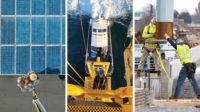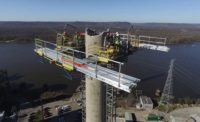Global Nuclear Energy Spending Is Boosted at COP28 Climate Meeting

Fourth reactor of Barakah nuclear plant in the United Arab Emirates received its operating license in November—with the Gulf nation, the first in the region to have nuclear power, agreeing to the expansion pledge at the COP28 climate meeting, which it is hosting for the first time.
Photo: Emirates Nuclear Energy Corp.
As the COP28 climate change summit in Dubai, United Arab Emirates, nears its anticipated Dec. 12 close, agreement among attendee nations is far from certain on its most controversial measure—to reduce or phase out fossil fuel use.
But action to expand global nuclear power to reach net-zero greenhouse gas emission goals has gained more traction at this conference than others since 2015—with 22 nations agreeing last week to triple their source capacity by 2050—even with continuing environmental opposition and speculation on how or whether current market roadblocks related to permitting, financing and safety perceptions will allow the goal to be reached.
“For the first time in decades, European member states have joined forces to underline the need for nuclear as a clean source of energy capable of ensuring security of supply,” said Yves Desbazeille, director general of Nucleareurope, an alliance of 16 European countries. The agreement is in line with the group’s target of 150 GW of nuclear power in the European Union by 2050, he said.
Most of the signatory countries, particularly the U.S., Canada, U.K., France, Korea and Japan, already have long developed nuclear energy programs. Notably absent from the list is nuclear powerhouse China, which has said it aims to double its nuclear energy capacity by 2035, with 22 plants now under construction and more than 70 planned, according to media reports
Even so, U.S. Energy Secretary Jennifer Granholm said the U.S. would still need to add 200 GW of nuclear power to meet the goal.
At a Dec. 8 visit to the site of a planned Tennessee Valley Authority small modular reactor in Oak Ridge, Tenn., the first for the giant federal utility, she hinted that the U.S. Energy Dept. could share in cost reduction, according to the American Public Power Association. Cost was not disclosed, but TVA last year committed $200 million to the project and intends to seek a construction permit in 2024. “That risk I think is something that has to be shared," said Granholm.
Regulatory hurdles and safety concerns in the U.S. and elsewhere also remain key issues. The domestic nuclear industry came to a halt after the Three Mile Island accident in 1979, with risk perceptions reinforced in the West after Japan's Fukushima nuclear accident in 2011.
In an analysis released Dec. 6, the anti-nuclear World Nuclear Industry update called the COP28 target “highly unrealistic."
UAE Signs Nuclear Pact
The signup list also includes Morocco and Ghana, as well as global oil-producing leader UAE, which is COP28's controversisl host country this year, but is completing its first large nuclear reactor project—the four-unit, 5.6-GW Barakah complex in Abu Dhabi that cost about $24.5 billion and has partly operated since 2021. Intended to provide about 25% of Emirates power supply, it is only the second nuclear energy plant in the Persian Gulf region.
The project was developed by Emirates Nuclear Energy Corp. and Korea Electric Power Corp. (KEPCO), with KEPCO Engineering and Construction and Bechtel providing plant design and engineering and project management support; Korea-based Doosan handling construction and nuclear steam supply; Hyundai and Samsung C&T as civil works contractors, and Westinghouse contracted for technical assistance.
The UAE nuclear company also announced Dec. 11 an agreement with a U.K. energy developer to explore potential of deploying the firm's 24-MW molten salt reactor by about 2030.
COP28 officials also said plans are underway to hold what the International Atomic Energy Agency said was a “first-of-its-kind” nuclear energy summit next March in Brussels for top public and private sector nuclear energy officials and experts.
According to S&P Global Commodity Insights, global nuclear capacity will grow by 58% to 631 GW by 2050, with China and the US making up more than 50% of the total. The sector declined 4% year over year in 2022, according to the World Nuclear Association, which cited outages caused by weld problems in aging French reactors, unit phaseouts in Germany and the war in Ukraine.
But S&P Global also said nuclear power generation in Asia rose by 37 terrawatt hours last year, and has more than doubled over the past decade. "Three-quarters of the reactors in construction globally are in Asia," said the market research firm.
The agreement signed at COP28 could add an estimated 800 large reactors or a few thousand smaller ones to world capacity, said BNN Bloomberg, citing Seth Grae, CEO of American nuclear fuel technology firm Lightbridge, who also expected more countries to sign the Dec. 6 pledge.
“Nuclear energy is back,” said French President Emmanuel Macron, In an IAEA statement. Tripling production capacities “sends a powerful message to the world," he added. Macron called on the World Bank, international financial institutions and multilateral development banks "to include nuclear energy into their energy-lending policies. This is the only way to support the growth of nuclear infrastructure in emerging countries."
The U.S. Export-Import Bank and U.S. State Dept. announced earlier in the conference "a suite of ... financial tools to support SMR deployments and help U.S. exporters compete in this global market."
Patrick Fragman, Westinghouse CEO, noted “problems and cost overruns” in the firm's “first of their kind” previous generation of reactors, he told Reuters. "We know—we have the scars.”
That is why the pledge was necessary, said Jonathan Cobb, spokesman for the World Nuclear Association. “Governments are looking at the role they need to play. The [goal] ... won't just happen by business as usual,” he said.
In a statement, Greenpeace criticized what it said is Macron’s “pro-nuclear obsession, [which] masks his lack of seriousness when it comes to climate action.”
German Chancellor Olaf Scholz said he would oppose reopening the country’s three large nuclear plants and building others, despite calls for those actions by other politicians, although Germany is investing in nuclear fusion research, said media reports. The country's most recent plant closure was in April. Australia also did not support the COP-28 nuclear pledge, although the government's current political opposition does.
New-Gen Technology
U.S-based SMR developer TerraPower, owned by Bill Gates, announced on Dec. 4 at a related COP28-event an agreement with the UAE state-owned nuclear company to study potential development of advanced nuclear reactors there.
“Bringing advanced nuclear technologies to market is critical to meeting global decarbonization targets,” TerraPower CEO Chris Levesque said. The company has a demonstration project for its advanced Natrium small modular reactor underway in Wyoming, which is aimed to come online in 2030.
Korea Hydro and Nuclear Power CEO Jooho Wang said the firm would be able to build a small modular reactor in two years—with permits in hand—compared to 10 to 20 years for large ones.
The U.K. government also recently awarded Holtec Britain, a unit of the U.S.-based nuclear technology firm, $37 million in funding to complete generic design assessment of its SMR-300 small modular reactor. The firm, along with Rolls Royce, are competing to build the country’s next generation of reactors.
Nuclear minister Andrew Bowie said the government is committing public funds to the sector for the first time in a generation—“a multi-million investment to develop cutting-edge technology that could transform how power stations are built by making construction faster and cheaper.”
Also Holtec said Dec. 5 it plans to build two SMR-300 reactors in the U.S. at the Palisades Nuclear Plant site in Michigan, with the first to be commissioned by mid-2030. The firm said the reactors would each add 300 MW of power at the now closed plant, a former 800-MW facility it bought in 2022 with intent to restart operation by the end of 2025. The state also would provide $150 million and hopes to gain added federal funding.
In Illinois, Gov. J.B. Pritzker signed a measure Dec. 8 that will end by Jan. 1, 2026 a nearly four-decade moratorium on nuclear plant construction in the state, the latest to overturn similar bans. He had vetoed the measure in August, but legislators revamped it to limit the size of new facilities and focus also on small modular reactors
In Canada, nuclear design veteran AtkinsRealis announced Nov. 28 a new design of the full-scale CANDU nuclear reactor that it says meets net zero and energy security needs. The reactor design can integrate a clean hydrogen production plant and storage facility into a nuclear station and use surplus plant heat to make hydrogen generation more efficient, the firm said. There are 34 CANDU plants globally, said the Canadian Nuclear Association, of which 30 are operable. Nineteen are in Canada
COP28 leaders from the US, Canada, France, Japan and the UK also said they would deploy $4.2 billion in government-led investments to increase uranium enrichment and conversion capacity and set up a supply market to counter Russia’s current control.
U.S. Climate Envoy John Kerry also said the U.S. will work with 35 other governments to accelerate nuclear fusion research and development, supply chain and safety.
"We are not making the argument to anybody that this is absolutely going to be a sweeping alternative to every other energy source," he said. "But the science and reality of facts and evidence tell us that you can't get to net zero by 2050 without some nuclear."





